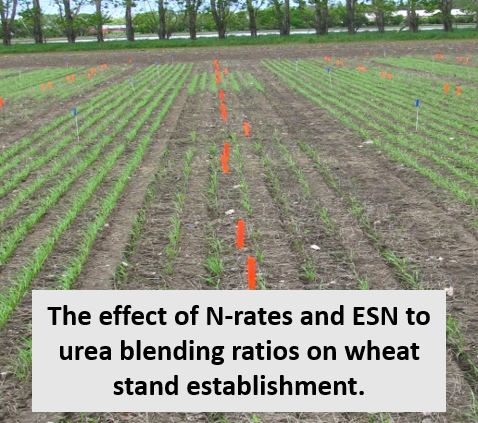Applying nitrogen with the planter using ESN (Environmentally Sensitive Nitrogen) and Urea: research update

Applying fertilizer down the tube with the seed is a time and cost-saving practice which eliminates the need for additional equipment to apply fertilizer. In the case of urea, it also mitigates losses from volatilization. The challenge with this method is avoiding a substantial reduction in stand due to the damage that urea causes when it comes in close contact with the seed. Yet, there is growing interest in using this method and some farmers have reported positive outcomes with it.
ESN is a slow release nitrogen (N) fertilizer product made of polymer coated urea granules. It has been shown to be a good alternative to uncoated urea when it comes to in-furrow nitrogen application. However, due to the price difference and availability there was interest in looking at blending ESN with urea to see what the lowest ESN to urea ratio might be that can still safely be applied with the seed. For this reason a trial was set up in 2013 and 2014 in Carrington to test the safety and yield effects of ESN blended with urea and applied at different rates at planting.
Excerpts from the results of this study are shown in the graphs.
In this trial, ESN and urea were applied with the seed at different blending ratios and at different N rates. Seed applied fertilizer treatments were compared with broadcast application. Early season stand counts showed that damage to the seed increased with nitrogen rates and with urea to ESN blending ratios in both years. In 2013, the stand was especially harshly affected by seed damage from urea, which caused significant reduction in the yield as well. The plots receiving 100% ESN with the seed did not suffer a great reduction in stand, and the yield was higher than the yield from broadcast application of the same N rate. In 2014, there was no significant difference between the yields and stand counts for the different blending ratios. Stand counts were reduced at higher N rates. In spite of this, grain yield increased with N rates regardless of ESN to urea blending ratio. The 2014 results might suggest that at the 90 lbs/A nitrogen rate, ESN can be blended with urea up to 50% to reduce cost and can still be safely applied with the seed. On the other hand, the 2013 results suggest a more cautious approach. The difference in the outcomes of the two years is possibly due to the length of time that passed between planting and the first major rainfall event. In 2013 it rained 0.27 inches 3 days after planting and 0.13 inches the day after that. In 2014 it rained 0.37 inches within 24 hours of planting and 0.24 inches the day after that. In addition, soil temperature or moisture status may have played a part in minimizing the burning effect of urea on the seeds at these different dates. For example, the NDAWN turf soil temperature for 2014 (45°F) was 20 degrees less than in 2013 (64°F).This study will be continued in 2015 to collect additional data before any conclusions can be drawn.
Summary:
- In 2013, seed contact with plain urea caused significant reduction in yield, but plots receiving 100% ESN had good yield response to N-rates.
- In 2014, grain yield increased with nitrogen rates regardless of ESN to Urea blending ratio.
- Difference between two seasons possibly due to how soon plots received rainfall after planting.
- More data to be collected in 2015.
Szilvia Zilahi-Sebess
Agronomy Research Specialist


